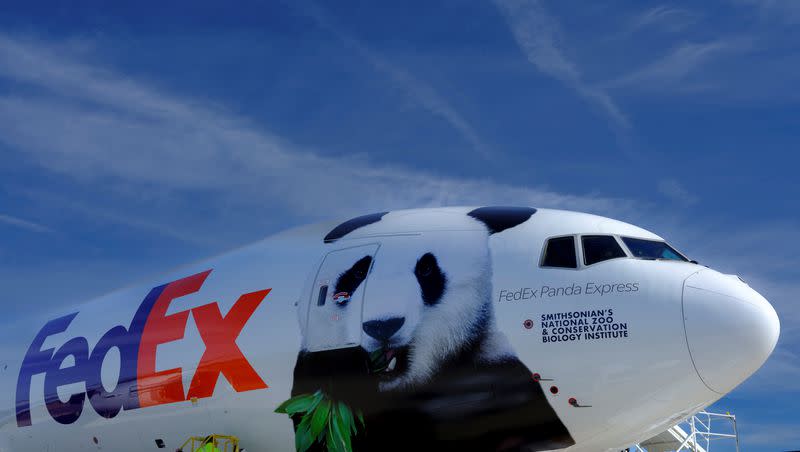3 giant pandas leave Washington D.C. and travel to China in a 19-hour flight

Three giant pandas officially left the U.S. on Wednesday to embark on a 19-hour flight to China.
Traveling in crates aboard a FedEx jumbo jet called the Giant Panda Express, pandas Mei Xiang, Tian Tian and their 3-year-old cub Xiao Qi Ji will head to East Asia.
For now, this marks an end in the panda diplomacy between Washington, D.C., and China for now.
Related
The pandas had animal care experts on board who provided in-flight amenities they love, like bamboo, sugar cane, sweet potatoes and leaf eater biscuits.
Arriving in Chengdu, in Southwest China, the pandas were greeted by their new keepers on the tarmac before they were moved to a quarantining facility for 30 days, according to FedEx.
The Smithsonian National Zoo in Washington, D.C., which was home to these pandas, hosted the Panda Palooza in October and invited thousands of fans of the furry creatures to say farewell before the panda trio left for China.
Millions have connected with Mei Xiang, Tian Tian and their cubs by visiting us in Washington, D.C., and watching our Giant Panda Cam. Although this farewell is bittersweet, we must celebrate these pandas and their impact on our understanding, care and conservation. #PandaStory pic.twitter.com/IsNssUtmjp
— National Zoo (@NationalZoo) November 8, 2023
Maryland resident Erica Jones, told a radio station in Washington that she attended the event to catch a last glimpse of her favorite animals.
“I’m super sad about them leaving,” she said, standing in a panda-themed outfit. “I wish they would stay longer. This will be my daughter’s first time seeing the pandas, and I would love for her to see them some more.”
Mei Xiang and Tian Tian arrived at the zoo in 2000 as a part of the Giant Panda Cooperative Research and Breeding Agreement the U.S. struck with China.
History behind ‘panda diplomacy’
“Many people don’t realize it, but there are actually two Chinese ambassadors in Washington: Me and the panda cub at the National Zoo,” wrote Cui Tiankai, China’s then-ambassador to the United States, in 2013, in a Washington Post opinion piece when Bao Bao, a panda cub, was born in Washington, D.C.
The panda cub was sent to China when she turned 3, according to The Guardian.
Under the agreement forged during the Richard Nixon era, the Chinese pandas living in the U.S. still belong to Beijing, as do the foreign-born cubs.
Pandas first arrived in the U.S. more than half a century ago. The Nixons were at a dinner with the then-Chinese Premier Zhou Enlai in 1972, when first lady Pat Nixon mentioned that she was fond of the creatures. Zhou simply replied, “I’ll give you some.” He sent her two of the giant animals, and so began the panda diplomacy.
The giant panda is the national Chinese icon that became culturally significant after 1949, as Elena E. Songster explored in her book “Panda Nation: The Construction and Conservation of China’s Modern Icon.” These creatures symbolize peace and friendship, while their black-and-white color is consistent with the Chinese beliefs of Yin and Yang.
China has acknowledged using the cuddly creatures for diplomatic purposes.
“The two sides have formed good cooperative relations, achieved fruitful results and played a positive role in protecting endangered species,” said spokesperson Mao Ning of China’s Ministry of Foreign Affairs, per CNN.
This may explain why Chinese pandas are loaned to at least 23 countries.
“The purpose is to better protect endangered species and promote global biodiversity conservation,” the spokesperson added.
The giant pandas are no longer on the endangered species list, with the population seeing a 17% increase in the last decade, according to Zoo Atlanta.
Will the pandas come back?
After their arrival to the U.S. in 2000, Mei Xiang and Tian Tian were leased for 10 years at a time, an agreement that was renewed many times. The National Zoo was paying $500,000 a year to lease these animals.
Bloomberg reported that the National Zoo is going to spend $1.7 million in renovating the enclosure, which would create a new climbing structure and a large pool, for these animals in hopes that the pandas come back one day.
Right now, only two panda cubs and their parents remain in the U.S. at a zoo in Atlanta, after China took back pandas from other U.S. zoos. The remaining ones are expected to return to China in 2024.
One zoo visitor had an idea to bring back the animals — and it involved first lady Jill Biden.
“Pat Nixon got the pandas here,” Jane Mahalik told CNN, “and Jill Biden should go and get these pandas back for us.”

